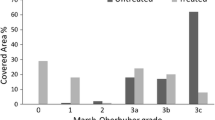Abstract
Endoscopic findings have been described for the diagnosis of celiac disease but the relationship amond the clinical presentation, endoscopic markers, and the degree of histopathological findings is not clear. Thirty patients who were thought to have celiac disease were included in this study. Biopsies taken from the duodenum were examined histopathologically. The relationship among the endoscopic, clinical, and histopathological findings were investigated. Partial villous atrophy was seen in 14 patients (46.6%), and subtotal and total villous atrophy were seen in 6 (20%) patients each. Eighty six percent of patients with a mosaic appearance, 76% of patients with the finding of loss of folds, and 90% of patients with scalloping on endoscopy had either partial villous atrophy, subtotal villous atrophy, or total villous atrophy on biopsy. We conclude that endoscopic findings in celiac disease can reveal valuable information both for diagnosis and for demonstration of the severity of the disease state.

Similar content being viewed by others
References
Farrel RJ, Kelly CP (2001) Diagnosis of celiac sprue. Am J Gastroenterol 96(12):3237–3246
Rostom A, Dube C, Cranney A, Saloojee N, SY R, Garritty C, Sampson M, Zhang L, Yazdı F, Mamaladze V, Pan I, Macneil J, Mack D, Patel D, Moher D (2005) The diagnostic accuracy of serologic tests for celiac disease: A systematic review. Gastroenterology 128:38–46
Stevens FM, McCarthy CF (1976) The endoscopic demonstration of coeliac disease. Endoscopy 8:177–180
Jabbari M, Wild G, Gorensky CA, Daly DS, Lough JO, Cleland P, Kinnear DG (1988) Scalloped valvulae conniventes: an endoscopic marker of celiac sprue. Gastroenterology 95:1518–1522
Brocchi E, Corazza GR, Caleti G, Treggiari EA, Barbara L, Gasbarrini G (1988) Endoscopic demonstration of loss of duodenal folds in the diagnosis of celiac disease. N Engl J Med 319:741–744
Brocchi E, Corazza GR, Brusco G, Mangia L, Gasbarrini G (1996) Unsuspected celiac disease diagnosed by endoscopic visualization of duodenal bulb micronodules. Gastrointest Endosc 44:610–611
Dickey W, Hughes D (2001) Disappointing sensitivity of endoscopic markers for villous atrophy in a high-risk population: implication for celiac disease diagnosis during routine endoscopy. Am J Gastroenterol 96:2126–2128
Bardella MT, Minoli G, Radaelli F, Quatrini M, Bianchi PA, Conte D (2000) Reevaluation of duodenal endoscopic markers in the diagnosis of celiac disease. Gastrointest Endosc 51:714–716
Shah VH, Rotterdam H, Kotler DP, Fasano A, Green PHR (2000) All that scallops is not celiac disease. Gastrointest Endosc 51:717–720
Marsh MN (1992) Gluten, major histocompatibility complex, and the small intestine. A molecular and immunobiologic approach to the spectrum of gluten sensitivity (celiac sprue). Gastroenterology 102:330–354
Parnell ND, Ciclitira PJ (2001) Review article: Celiac disease and its management. Alimentary Pharmacol Ther 120:1522–1525
Tatar G, Elsurer R, Simsek H, Balaban YH, Hascelik G, Ozcebe OI, Buyukasık Y, Sokmensuer C (2004) Screening of tissue transglutaminase antibody in healthy blood donors for celiac disease screening in the Turkish population. Dig Dis Sci 49:1479–1484
Catassi C, Ratsch IM, Gandolfi L, Pratesi R, Fabiani E, Asmar RE, Frijia M, Bearzi I, Vizzoni L (1999) Why is coeliac disease endemic in the people of the Sahara? Lancet 354:647–648
Shahbazkhani B, Malekzadeh R, Sotoudeh M, Moghadam KF, Farhadi M, Ansari R, Elahfar A, Rostami K (2003) High prevalence of celiac disease in apparently healthy Iranian blood donors. Eur J Gastroenterol Hepatol 15:475–478
Tursi A, Brandimarte G, Giorgetti GM, Gigliobianco A (2002) Endoscopic features of celiac disease in adults and their correlation with age, histolojical damage, and clinical form of the disease. Endoscopy 34(10):787–792
Dickey W, Hughes D (1999) Prevalence of celiac disease and its endoscopic markers among patients having routine upper gastrointestinal endoscopy. Am J Gastroenterol 94:2182–2186
Corazza GR, Caletti GC, Lazzari R, Collina A, Brocchi E, Di Sario A, Ferrari A, Gasbarrini G (1993) Scalloped düodenal folds in childhood celiac disease. Gastrointest Endosc 39:543–545
Ravelli AM, Tobanelli P, Mineli L, Villanacci V, Cestari R (2001) Endoscopic features of celiac disease in children. Gastrointest Endosc 54:736–742
Dickey W (1998) Diagnosis of coeliac disease at open-access endoscopy. Scand J Gastroenterol 33:612–615
McIntyre AS, Nq DP, Smith JA, Amoah J, Long RG (1992) The endoscopic appearance of duodenal folds is predictive of untreated adult celiac disease. Gastrointest Endosc 38:148–151
Brocchi E, Tomassetti P, Misitano B, Epifanio G, Corinaldesi R, Bonvicini F, Gasbarrini G, Corazza G (2002) Endoscopic markers in adult coeliac disease. Dig Liver Dis 34:177–182
Magazzu G, Bottari M, Tuccari G, Arco A, Pallio S, Lucanto C, Tortora A, Barresi G (1994) Upper gastrointestinal endoscopy can be a reliable tool for celiac sprue in adults. J Clin Gastroenterol 19:255–259
Oxentenko AS, Grisolano SW, Murray JA, Burgart LJ, Dierkhising RA, Alexander JA (2002) The insensitivity of endoscopic markers in celiac disease. Am J Gastroenterol 97:933–938
Author information
Authors and Affiliations
Corresponding author
Rights and permissions
About this article
Cite this article
Savas, N., Akbulut, S., Saritas, U. et al. Correlation of Clinical and Histopathological with Endoscopic Findings of Celiac Disease in the Turkish Population. Dig Dis Sci 52, 1299–1303 (2007). https://doi.org/10.1007/s10620-006-9540-3
Received:
Accepted:
Published:
Issue Date:
DOI: https://doi.org/10.1007/s10620-006-9540-3




